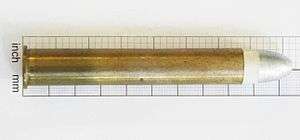.50-140 Sharps
| .50-140 Sharps | ||||||||
|---|---|---|---|---|---|---|---|---|
 .50-140 Sharps cartridges | ||||||||
| Type | Black-powder rifle | |||||||
| Place of origin | USA | |||||||
| Service history | ||||||||
| Used by | USA | |||||||
| Production history | ||||||||
| Designed | 1884 | |||||||
| Produced | 1884 | |||||||
| Specifications | ||||||||
| Parent case | .50 Basic | |||||||
| Case type | Rimmed, straight-taper | |||||||
| Bullet diameter | .512 in (13.0 mm) | |||||||
| Neck diameter | .529 in (13.4 mm) | |||||||
| Shoulder diameter | .529 in (13.4 mm) | |||||||
| Base diameter | .551 in (14.0 mm) | |||||||
| Rim diameter | .652 in (16.6 mm) | |||||||
| Case length | 3.25 in (83 mm) | |||||||
| Overall length | 3.95 in (100 mm) | |||||||
| Primer type | Large rifle | |||||||
| Ballistic performance | ||||||||
| ||||||||
|
Test barrel length: 30" Source(s): The Complete Blackpowder Handbook [1] | ||||||||
The .50-140 Sharps rifle cartridge is a black-powder cartridge that was introduced in 1884 as a big game hunting round.[1] It is believed to have been introduced for the Sharps-Borchardt Model 1878 rifle.[2] The cartridge is very similar to the .500 Black Powder Express.[3]
This round was introduced by Winchester 3 years after the Sharps Rifle Company closed its doors in 1881. It is similar to, though larger than, the .50-90 Sharps.
Specifications
Bullet diameter was typically .512 in (13.0 mm), with weights ranging from 600 to 700 grains (39 to 45 g) were used.
The powder charge was typically 140 grains (9.1 g) of black powder. Modern substitutes such as Pyrodex are sometimes used, although using smaller charges since pyrodex is less dense than black powder.[4] In a strong action with modern smokeless powder it can exceed a 500-grain (32 g) .458 Winchester Magnum velocity while using a heavier 550-grain (36 g) bullet.[5]
History
The .50-140 was created specifically with big game hunting in mind, and was the most powerful of the Sharps Buffalo cartridges.[5] However, this cartridge was introduced about the time that the last of the great buffalo herds had been destroyed.[6] An obsolete round, ammunition is not produced by any major manufacturer although reloading components and brass can be bought.
Rifles are produced on an infrequent basis by a few companies. The rifles are typically used for buffalo hunting and reenactments. Occasionally the .50-140 is used in vintage competitions, but it produces more recoil than other old-time cartridges such as the .45-70, and so is used less frequently.
See also
References
- 1 2 The Complete Blackpowder Handbook (3rd Edition), Book by Sam Fadala, Krause Publishing, 1996 p.248
- ↑ Walter, John (2006). The Guns that Won the West: Firearms on the American Frontier, 1848-1898. Greenhill Books. p. 264. ISBN 978-1-85367-692-5.
- ↑ Wieland, Terry (2006). Dangerous-Game Rifles. Countrysport Press. p. 283. ISBN 978-0-89272-691-2.
- ↑ Fadala, Sam (2006). The Complete Blackpowder Handbook (5th ed.). Gun Digest Books. p. 203. ISBN 978-0-89689-390-0.
Second, Pyrodex provides more shorts per pound than blackpowder because it is less dense.
- 1 2 ".50-140 Sharps" (PDF). Accurate Powder. Western Powders Inc. Retrieved 23 September 2010.
- ↑ Hawks, Chuck. "Buffalo Cartridges of the American Frontier". ChuckHawks.com. Archived from the original on 10 October 2010. Retrieved 23 September 2010.
- Accurate Smokeless Powders Loading Guide Number Two (Revised), Book by Accurate Arms Co, Wolfe Publishing, 2000 p. 371